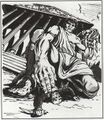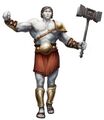Titan (D&D)

Titans used to be a breed of uber-giant in the worlds of Dungeons & Dragons. Their precise definition has varied between editions; 5e representing the most drastic departure.
- Original Dungeons & Dragons had them as not-ugly, not-stupid giants in the Greyhawk supplement.
- Advanced Dungeons & Dragons had them in the Monster Manual, 17-22 hit dice and 7d6 points of damage on a normal attack, could cast any magic-user or cleric spells as if level 15, had eight psionic powers but were immune to psionic attack, and invisible at-will. They looked like beautiful 18-foot tall Greek giants. Levitate or ethereal twice a day.
- Manual of the Planes put most of their leaders in Tarterus (now Carceri), in accordance with their classical roots.
- AD&D2 had them in the Monstrous Compendium #8. This buffing their AD&D appearance: 20 hit dice, 7d6 damage from normal attack that they can do twice per round, can do a 10d6 special attack, can go ethereal twice a day, casts spells as a level 20 wizard or cleric, has a grab-bag of utility powers like Levitate, Invisibility, Alter Self and Advanced Illusion usable at will once per round, and even can have a "thematically appropriate" special-snowflake power (given examples are creating water for sea-themed titan, removing all negative feelings such as hatred or depression for a love-themed titan and instakill for a death-themed titan).
- Planescape ran with their MotP villainy. In fact Carceri took its very name from the prison-plane aspect of Tarterus, whose main prisoners were exactly the elder Titans. Most adventures which touch upon Carceri will involve making some deal with this-or-that embittered Titan.
- Dungeons & Dragons 3rd Edition had them in the Monster Manual as 25-foot perfect Greek-god humanoids with a dozen at-will arcane & divine spells as if level 20, and had a challenge rating of 21 (the Tarrasque is a 20). Levitate at-will, ethereal or gate twice a day.
- Dungeons & Dragons 4th Edition uses Titans as giants that are more elemental-y and 3 levels higher than normal giants. And somehow "necrotic" became an elemental thing. They're even uglier than giants, and these titans can't levitate. They were created by the Primordials for the sole purpose of wrecking everyone's shit, which is the only reason the Primordials ever created anything.
Dungeons & Dragons 5th Edition changes-up the definition. There's no more lore for the classical humanoid Titan. Instead some few select creatures (as of the release of Fizban's Treasury of Dragons: only seven) take the "Titan" tag. The only thing these creatures have in common seems to be that they are of ridiculous power and involved, somehow, with the Divine:
- Empyreans, who are the children of gods;
- Astral Dreadnoughts, who were made by Dread Tharizdun;
- Atropals, who are stillborn gods;
- Krakens, who were created as living weapons by the gods, and Tromokratis (Mythic Odysseys of Theros), basically greek Krakens from the god of sea Thassa;
- and the Tarrasque.
Gallery
-
1e
-
2e
-
3e
-
5e's Empyrean is the Titan of older editions in all but name.
| The Giants of Dungeons & Dragons | |
|---|---|
| Giants | Beasthead Giant - Cloud Giant - Crag Giant - Cyclops - Desert Giant - Ettin - Firbolg - Fire Giant - Fog Giant - Fomorian - Forest Giant - Frost Giant - Half-Giant - Hephaeston - Hill Giant - Ice Giant - Jungle Giant - Mountain Giant - Ogre - Plains Giant - Reef Giant - Sea Giant - Spacesea Giant - Stone Giant - Storm Giant - Titan - Verbeeg - Voadkyn |




